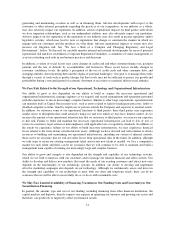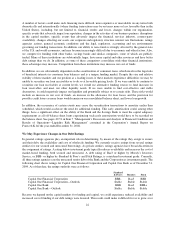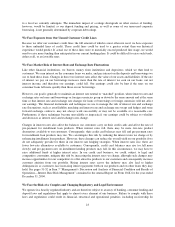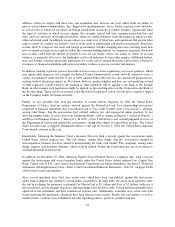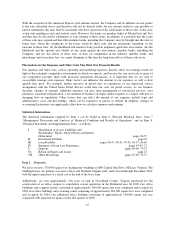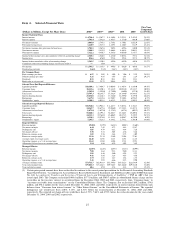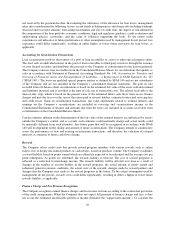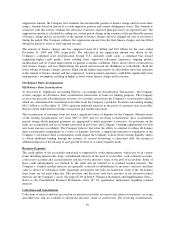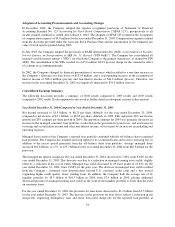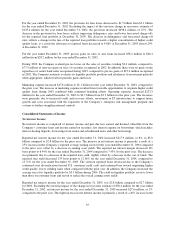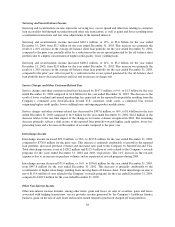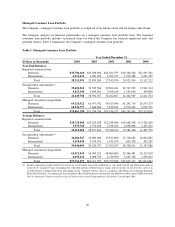Capital One 2004 Annual Report Download - page 53
Download and view the complete annual report
Please find page 53 of the 2004 Capital One annual report below. You can navigate through the pages in the report by either clicking on the pages listed below, or by using the keyword search tool below to find specific information within the annual report.
suppression amount, the Company first estimates the uncollectible portion of finance charge and fee receivables
using a formula based on historical account migration patterns and current delinquency status. This formula is
consistent with that used to estimate the allowance related to expected principal losses on reported loans. The
suppression amount is calculated by adding any current period change in the estimate of the uncollectible portion
of finance charge and fee receivables to the amount of finance charges and fees charged-off (net of recoveries)
during the period. The Company subtracts the suppression amount from the total finance charges and fees billed
during the period to arrive at total reported revenue.
The amount of finance charges and fees suppressed were $1.1 billion and $2.0 billion for the years ended
December 31, 2004 and 2003, respectively. The reduction in the suppression amount was driven by the
Company’s continued asset diversification beyond U.S. consumer credit cards, a continued bias toward
originating higher credit quality, lower yielding loans, improved collections experience, ongoing product
modifications and an overall improvement in general economic conditions. These factors drove a reduction in
total finance charges and fees billed during the period and increased the likelihood of collectibility. Both the
lower volume of finance charges and fees billed and the higher expectations of collectibility drove the reduction
in the amount of finance charges and fees suppressed. Actual payment experience could differ significantly from
management’s assumption, resulting in higher or lower future finance charge and fee income.
Off-Balance Sheet Arrangements
Off-Balance Sheet Securitizations
As discussed in “Significant Accounting Policies—Accounting for Securitization Transactions,” the Company
actively engages in off-balance sheet securitization transactions of loans for funding purposes. The Company
receives the proceeds from third party investors for securities issued from the Company’s securitization vehicles
which are collateralized by transferred receivables from the Company’s portfolio. Securities outstanding totaling
$41.2 billion as of December 31, 2004, represent undivided interests in the pools of consumer loan receivables
that are sold in underwritten offerings or in private placement transactions.
The securitization of consumer loans has been a significant source of liquidity for the Company. Maturity terms
of the existing securitizations vary from 2005 to 2019 and, for revolving securitizations, have accumulation
periods during which principal payments are aggregated to make payments to investors. As payments on the
loans are accumulated and are no longer reinvested in new loans, the Company’s funding requirements for such
new loans increase accordingly. The Company believes that it has the ability to continue to utilize off-balance
sheet securitization arrangements as a source of liquidity; however, a significant reduction or termination of the
Company’s off-balance sheet securitizations could require the Company to draw down existing liquidity and/or
to obtain additional funding through the issuance of secured borrowings or unsecured debt, the raising of
additional deposits or the slowing of asset growth to offset or to satisfy liquidity needs.
Recourse Exposure
The credit quality of the receivables transferred is supported by credit enhancements, which may be in various
forms including interest-only strips, subordinated interests in the pool of receivables, cash collateral accounts,
cash reserve accounts and accrued interest and fees on the investor’s share of the pool of receivables. Some of
these credit enhancements are retained by the seller and are referred to as retained residual interests. The
Company’s retained residual interests are generally restricted or subordinated to investors’ interests and their
value is subject to substantial credit, repayment and interest rate risks on transferred assets if the off-balance
sheet loans are not paid when due. The investors and the trusts only have recourse to the retained residual
interests, not the Company’s assets. See pages 87-89 in Item 8 “Financial Statements and Supplementary Data—
Notes to the Consolidated Financial Statements—Note 18” for quantitative information regarding retained
interests.
Collections and Amortization
Collections of interest and fees received on securitized receivables are used to pay interest to investors, servicing
and other fees, and are available to absorb the investors’ share of credit losses. For revolving securitizations,
30



